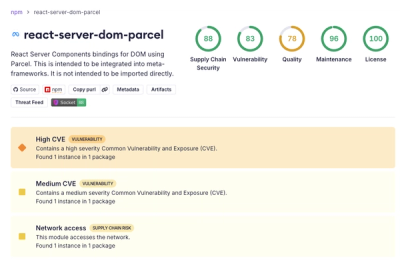
Security News
Deno 2.6 + Socket: Supply Chain Defense In Your CLI
Deno 2.6 introduces deno audit with a new --socket flag that plugs directly into Socket to bring supply chain security checks into the Deno CLI.
stackmanager
Advanced tools
Utility to manage CloudFormation stacks based upon a Template (either local or in S3) and a YAML configuration file.
Uses ChangeSets to create or update CloudFormation stacks, allowing the ChangeSets to either be automatically applied or applied later (e.g. during a later phase of a build pipeline after review of the ChangeSet).
There are also some utility methods for building a lambda file zip and uploading files to S3. These are to provide some of the AWS SAM CLI functionality while fitting into the workflow and configuration style of stackmanager.
stackmanager is available as a Python package or a Docker image based upon Debian.
The Docker image can be used to run container jobs in Azure DevOps pipelines and potentially other CI/CD products.
The configuration file can either be a single YAML document containing the configuration for a stack for a specific environment and region, or can contain multiple documents for different deployments of that stack to different environments and regions.
The configuration combines together the different values that are typically passed to the CloudFormation command line when creating or updating a CloudFormation stack.
Environment: dev
StackName: "{{ EnvironmentCode }}-StackManager-Integration"
Region: us-east-1
Parameters:
Environment: "{{ Environment }}"
Tags:
Application: StackManager
Environment: "{{ Environment }}"
Variables:
EnvironmentCode: d
Template: integration/template.yaml
Capabilities:
- CAPABILITY_NAMED_IAM
The configuration file makes use of Jinja2 templating to perform
replacements into the StackName, Parameters and Tags values using the Environment and Region values
and any values from the Variables section.
It's also possible to make use of Jinja2 filters, for example to lowercase the Environment to pass into a parameter that is going to be used where it's required to be lowercase (e.g. in forming a bucket name):
Parameters: LowerEnvironment: "{{ Environment|lower() }}"
---
Environment: all
StackName: "{{ EnvironmentCode }}-StackManager-Integration-{{ Region }}"
Parameters:
Environment: "{{ Environment }}"
Tags:
Application: StackManager
Environment: "{{ Environment }}"
Template: integration/template.yaml
---
Environment: dev
Region: us-east-1
Variables:
EnvironmentCode: d
---
Environment: dev
Region: us-east-2
Variables:
EnvironmentCode: d
---
Environment: prod
Region: us-east-1
Tags:
CostCenter: 200
Variables:
EnvironmentCode: p
---
Environment: prod
Region: us-east-2
Tags:
CostCenter: 300
Variables:
EnvironmentCode: p
A multi-environment configuration can be used to combine all the configurations for different versions of a stack
across environments and regions, using inheritance from a specially named all Environment to avoid the need
to repeat values.
Because of the special handling of the
allEnvironment, it's not possible to deploy an environment namedall.
| Name | Required | Templated | Notes |
|---|---|---|---|
| Environment | Yes | No | Name of environment to be deployed |
| Region | Yes | No | AWS region (e.g. us-east-1) - not required for the 'all' environment |
| Parameters | No | Yes | Each parameter value is templated, and parameters are inherited from 'all' |
| Tags | No | Yes | Each tag value is templated, and tags are inherited from 'all' |
| Variables | No | No | Values are inherited from all and then substituted into StackName, Parameters and Tags |
| Capabilities | No | No | List of capabilities (e.g. CAPABILITY_IAM) |
| Template | No | No | Can be supplied on command line, so not required in configuration |
| TerminationProtection | No | No | Termination Protection defaults to True |
In
1.2.0, Termination Protection support was added and defaults to True, set to False in config.yml to disable. When deleting a stack using stackmanager, termination protection will be automatically disabled.
Stackmanager has the following commands:
deploy - Create or update a CloudFormation stack for a specific environment/region using a ChangeSet. By default exits after creating the changeset, but can --auto-apply.apply - Apply a previously created ChangeSetreject - Reject a previously created ChangeSetdelete - Delete an existing CloudFormation stackstatus - Print current status of Stackget-output - Get Stack Output valueupload - Uploads a local file to S3. Utility method to prevent the need to use the AWS CLI or other tools.build-lambda - Build a Lambda zip file using aws-lambda-builders.Usage: stackmanager [OPTIONS] COMMAND1 [ARGS]... [COMMAND2 [ARGS]...]...
Utility for managing CloudFormation stacks.
Options:
-p, --profile TEXT AWS Profile, will use default or environment variables if not specified
-r, --region TEXT AWS Region to deploy
--help Show this message and exit.
Commands:
apply Apply a CloudFormation ChangeSet to create or update a CloudFormation stack.
build-lambda Build a Lambda function zip file.
delete Delete a CloudFormation stack.
deploy Create or update a CloudFormation stack using ChangeSets.
get-output Returns matching Output value if it exists.
reject Reject a CloudFormation ChangeSet, deleting the stack if in REVIEW_IN_PROGRESS status and has no other ChangeSets.
status Print current status of Stack.
upload Uploads a File to S3.
The --profile and --region options can be set either on the root stackmanager command, or on the nested commands.
Multiple commands can be chained together, and the sequence of build-lambda -> upload -> deploy can be used to
deploy Lambda functions.
The path to the Zip file generated by
build-lambdais passed as the--filenameoption onupload, and the S3 bucket and key from theuploadcommand is passed as parameters to thedeploycommand.
Usage: stackmanager deploy [OPTIONS]
Create or update a CloudFormation stack using ChangeSets.
Options:
-p, --profile TEXT AWS Profile, will use default or environment variables if not specified
-c, --config-file TEXT YAML Configuration file [required]
-e, --environment TEXT Environment to deploy [required]
-r, --region TEXT AWS Region to deploy [required]
-t, --template TEXT Override template
--parameter TEXT... Override a parameter, can be specified multiple times
--parameter-use-previous TEXT Use previous value for a parameter, can be specified multiple times
--change-set-name TEXT Custom ChangeSet name
--existing-changes [ALLOW|FAILED_ONLY|DISALLOW]
Whether deployment is allowed when there are
existing ChangeSets
--auto-apply Automatically apply created ChangeSet
--help Show this message and exit.
The --parameter argument can be supplied multiple times and requires two values (the key and the value),
for example:
stackmanager deploy --parameter LambdaBucket mybucket --parameter LambdaKey mykey ...
The --parameter-use-previous argument can be supplied multiple times and requires one value (the name of the parameter),
and is typically used when a previous run has supplied a --parameter argument either as an override or for a value
not included in the configuration.
If
--parameterand--parameter-use-previousare specified for the same parameter name, the--parametervalue will be used.
Existing ChangeSets, if any, will be listed for the stack and depending upon the --existing-changes
value (which defaults to ALLOW) this may prevent the deployment. If set to FAILED_ONLY then failed ChangeSets
will not prevent a new change from being created, but if set to DISALLOW any existing ChangeSets will prevent new
changes.
Usage: stackmanager apply [OPTIONS]
Apply a CloudFormation ChangeSet to create or update a CloudFormation stack.
If using --change-set-name then --config --environment are --region are required.
If using --change-set-id no other values are required (although --profile and --region may be needed).
Options:
-p, --profile TEXT AWS Profile, will use default or environment variables if not specified
-c, --config-file TEXT YAML Configuration file
-e, --environment TEXT Environment to deploy
-r, --region TEXT AWS Region to deploy
--change-set-name TEXT Name of ChangeSet to apply
--change-set-id TEXT Identifier of ChangeSet to apply
--help Show this message and exit.
(since 0.7.0) Using --change-set-id allows you to apply a ChangeSet without loading the configuration.
This can be useful in a CI/CD pipeline as this may avoid the need to checkout the repository for applying a change.
Usage: stackmanager reject [OPTIONS]
Reject a CloudFormation ChangeSet, deleting the stack if in REVIEW_IN_PROGRESS status and has no other ChangeSets.
If using --change-set-name then --config --environment are --region are required.
If using --change-set-id no other values are required (although --profile and --region may be needed).
Options:
-p, --profile TEXT AWS Profile, will use default or environment variables if not specified
-c, --config-file TEXT YAML Configuration file
-e, --environment TEXT Environment for stack
-r, --region TEXT AWS Region for stack
--change-set-name TEXT Name of ChangeSet to reject
--change-set-id TEXT Identifier of ChangeSet to reject
--help Show this message and exit.
Usage: stackmanager delete [OPTIONS]
Delete a CloudFormation stack.
Options:
-p, --profile TEXT AWS Profile, will use default or environment variables if not specified
-c, --config-file TEXT YAML Configuration file [required]
-e, --environment TEXT Environment to deploy [required]
-r, --region TEXT AWS Region to deploy [required]
--retain-resources TEXT Logical Ids of resources to retain
-Y, --yes Confirm the action without prompting.
--help Show this message and exit.
Since
1.2.0deletion requires a confirmation, either interactively or by supplying the-Y/--yesoption. Deletion also now automatically removes termination protection (the logic being that you've confirmed you want to delete).
Sometimes it's necessary to get an output value from a stack to pass to something else. While SSM parameter store or CloudFormation exports are a preferred way to pass values between stacks, this can be used to pass a value from one stackmanager execution to another (e.g. when they are in different regions):
myoutput=$(stackmanger get-output -e dev -r us-east-1 -c mystack.yml -o OutputKey)
The output value will be the only value written to stdout.
If the stack does not exist, or a matching output does not exist an error will be printed to stderr and the return code will be -1.
Usage: stackmanager get-output [OPTIONS]
Returns matching Output value if it exists.
Options:
-p, --profile TEXT AWS Profile, will use default or environment variables if not specified
-c, --config-file TEXT YAML Configuration file [required]
-e, --environment TEXT Environment to deploy [required]
-r, --region TEXT AWS Region to deploy
-o, --output-key TEXT Output Key [required]
--help Show this message and exit.
Usage: stackmanager status [OPTIONS]
Print current status of Stack. Includes pending ChangeSets and recent events.
Options:
-p, --profile TEXT AWS Profile, will use default or environment variables if not specified
-c, --config-file TEXT YAML Configuration file [required]
-e, --environment TEXT Environment to deploy [required]
-r, --region TEXT AWS Region to deploy [required]
--event-days INTEGER Number of days of events to include in output
--help Show this message and exit.
Usage: stackmanager upload [OPTIONS]
Uploads a File to S3. This might be a large CloudFormation template, or a
Lambda zip file. Can be chained into the deploy command where it pre-populates
parameters for the uploaded file.
Options:
-p, --profile TEXT AWS Profile, will use default or environment variables if not specified
-r, --region TEXT AWS Region to upload to
-f, --filename TEXT File to upload
-b, --bucket TEXT Bucket to upload to [required]
-k, --key TEXT Key to upload to [required]
--bucket-parameter TEXT CloudFormation parameter for Bucket
--key-parameter TEXT CloudFormation parameter for Key
--help Show this message and exit.
Usage: stackmanager build-lambda [OPTIONS]
Build a Lambda function zip file. Can be chained into the upload command
where it pre-populates the --filename option.
Options:
-s, --source-dir TEXT Source directory [required]
-o, --output-dir TEXT Output directory [required]
--runtime TEXT Lambda Runtime [required]
--archive-name TEXT Override archive name (defaults to source directory name)
--help Show this message and exit.
Stackmanager will automatically detect when it is running in an Azure DevOps pipeline by looking for the
SYSTEM_TEAMPROJECTID environment variable.
It will print ##vso strings under the following circumstances:
deploy has created a ChangeSet and it has not been auto-applied: change_set_name and change_set_id
(since 0.7.0) but the name of these variables can be changed with the CHANGE_SET_NAME_VARIABLE and
CHANGE_SET_ID_VARIABLE environment variables. These values can be used with the apply command in a later stage.deploy has created a ChangeSet but it contains no changes:##vso[task.logissue]) and sets the status to SucceededWithIssues (##vso[task.complete])
allowing following steps/jobs/stages to be skipped by checking for the SucceededStatus in a condition.deploy or apply fails when applying a ChangeSet: ##vso[task.logissue])Future plans are to have a global configuration or a larger set of environment variables that can configure behavior.
By default displayed timestamps (e.g. for CloudFormation events) will be displayed in the detected local timezone
including the timezone offset. If you specify a timezone using the STACKMANAGER_TIMEZONE environment variable
then this will be used instead and the timezone offset will be omitted. Olson Timezones (e.g. America/New_York)
are supported.
FAQs
Utility to manage CloudFormation stacks using YAML configuration file
We found that stackmanager demonstrated a healthy version release cadence and project activity because the last version was released less than a year ago. It has 1 open source maintainer collaborating on the project.
Did you know?

Socket for GitHub automatically highlights issues in each pull request and monitors the health of all your open source dependencies. Discover the contents of your packages and block harmful activity before you install or update your dependencies.

Security News
Deno 2.6 introduces deno audit with a new --socket flag that plugs directly into Socket to bring supply chain security checks into the Deno CLI.

Security News
New DoS and source code exposure bugs in React Server Components and Next.js: what’s affected and how to update safely.

Security News
Socket CEO Feross Aboukhadijeh joins Software Engineering Daily to discuss modern software supply chain attacks and rising AI-driven security risks.